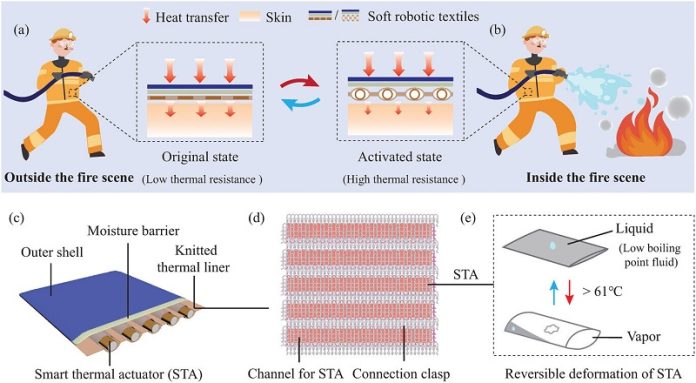
As global warming continues, people are increasingly exposed to extreme heat, making it crucial to stay comfortable, especially for those working in high-temperature environments.
To address this, Dr. Dahua Shou and his team at The Hong Kong Polytechnic University have developed a groundbreaking solution: soft robotic clothing that automatically adjusts to changing temperatures, ensuring safety and comfort in hot conditions.
Their innovative work has been published in Advanced Science.
Maintaining a stable body temperature is essential for staying healthy and safe. High temperatures can increase the risk of heat stress and worsen chronic health conditions like heart disease, diabetes, and asthma.
The World Health Organization reported nearly half a million heat-related deaths each year between 2000 and 2019, with many of these deaths occurring in Asia and Europe.
People who work in extreme heat, such as firefighters and construction workers, rely on protective clothing to shield them from high temperatures.
However, traditional gear has limitations. It often provides too much insulation in moderate conditions, leading to overheating, or not enough protection in extreme heat, which can be dangerous.
Dr. Shou’s team has developed intelligent soft robotic clothing that adapts to different temperatures, offering better protection and comfort.
Inspired by how pigeons regulate their body temperature by fluffing their feathers to trap warm air, the team designed clothing that uses soft robotic textiles to manage heat dynamically.
The clothing features soft actuators embedded within the fabric, filled with a non-toxic fluid. When the temperature rises, the fluid turns into a gas, causing the actuators to expand and increase the thickness of the fabric.
This traps more air and doubles the thermal resistance, helping to keep the wearer cool. The clothing can reduce the inner surface temperature by at least 10°C compared to traditional heat-resistant gear, even when the outer surface reaches 120°C.
Made from thermoplastic polyurethane, the fabric is soft, durable, and comfortable against the skin. It’s also more flexible and user-friendly than other temperature-responsive materials like shape-memory alloys.
The fabric’s unique structure reduces heat transfer while allowing moisture to escape, keeping the wearer cool and dry.
Unlike other cooling systems that rely on electricity or liquid circulation, this soft robotic clothing regulates temperature naturally, without using any energy. It’s lightweight and effective, making it ideal for a wide range of environments.
Dr. Shou was inspired to create this clothing after learning about the extreme discomfort firefighters experience in their heavy gear. His goal was to develop a suit that could adapt to different temperatures while remaining breathable.
Looking ahead, Dr. Shou sees many potential uses for this technology, including activewear, winter jackets, healthcare clothing, and even insulation for buildings. His team is also working on inflatable jackets and warm clothing for cold environments, helping people stay safe and comfortable in all conditions.



